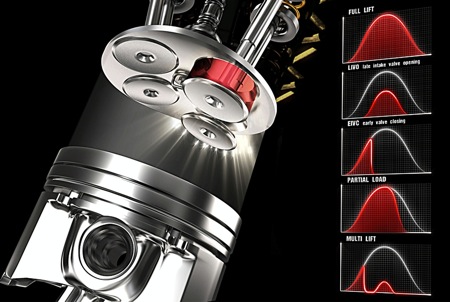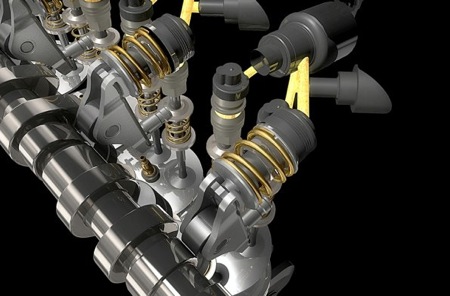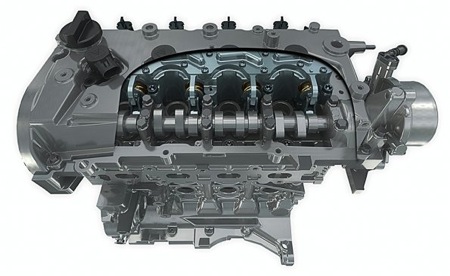Fiat has revealed a new engine technology called the MultiAir technology which significantly reduces emissions, while improving fuel economy and power delivery. This rather complicated electro-hydraulic variable valve actuation technology is implemented to the intake system. A piston is connected to the intake valve via a hydraulic chamber, which is controlled by a solenoid valve. The movement of this piston is controlled by a mechanical intake camshaft.
When the solenoid valve is closed, the oil in the hydraulic chamber behaves like a solid body and transmits the lift schedule to the intake valves. The lift schedule is imposed by the mechanical intake camshaft. When the solenoid valve is open on the other hand, the hydraulic chamber and the intake valves are de-coupled; the intake valves do not follow the intake camshaft anymore and close under the valve spring action.

The final part of the valve closing stroke is controlled by a dedicated hydraulic brake, to ensure a soft and regular landing phase in any engine operating conditions. Through solenoid valve opening and closing time control, a wide range of optimum intake valve opening schedules can be easily obtained. Continue reading to view more images and to watch a video.
To help improve power, the solenoid valve is always closed and full valve opening is achieved following completely the mechanical camshaft, which is specifically designed to maximize power at high engine speed (long opening time). For low rpm torque, the solenoid valve is opened near the end of the camshaft profile, leading to early intake valve closing. This eliminates unwanted backflow into the manifold and maximizes the air mass trapped in the cylinders.
In engine part-load, the solenoid valve is opened earlier, causing partial valve openings to control the trapped air mass as a function of the required torque. Alternatively the intake valves can be partially opened by closing the solenoid valve once the mechanical camshaft action has already started. In this case the air stream into the cylinder is faster and results in higher in-cylinder turbulence.

The last two actuation modes can be combined in the same intake stroke, generating a so-called Multilift mode that enhances turbulence and combustion rate at very low loads. To help you understand this very complicated system, there is a video to assist you. Overall, benefits include; 10% increase in power, 15% improvement in low rpm torque, 10% reduction in fuel consumption and emissions output for naturally aspirated engines, 25% improvement in fuel efficiency for turbocharged engines and between 40% - 60% reduction in emissions output during cold starts and warm up.

This new technology can also be adapted to all types of internal combustion engines including diesel. Fiat will first offer the MultiAir technology with the 16-valve 1.4 liter engine family, in both naturally aspirated and turbocharged forms. The first vehicle to carry the system would be the Alfa Romeo MiTo by end of this year.

No comments:
Post a Comment